
Table of Contents
Are you tired of staring at a blank social media content slate, wondering what to post next? You’re not alone. In today’s fast-paced digital world, creating engaging content consistently can feel like an uphill battle. But what if you could wave a magic wand and have a year’s worth of post ideas ready to go? Welcome to your 2024 social media content calendar, where we’re turning that wand into a reality!
Let’s start with a staggering fact: 4.2 billion people use social media worldwide, spending an average of 2 hours and 25 minutes per day scrolling through their feeds. That’s a lot of potential eyes on your content! But with so much noise out there, how do you ensure your posts stand out? The secret lies in strategic content planning and engagement strategies. That’s where this article comes in.
Agree: You understand the importance of a solid social media presence for your brand. You know that consistent, engaging content is key to growing your audience and driving results. But you’re also human, and coming up with fresh, exciting ideas every day is no easy feat. We’ve all been there, staring at the calendar, willing inspiration to strike.
Promise: This article is your lifeline. We’re giving you a whopping 52 weeks of post ideas, tailored to maximize engagement and keep your audience hooked. No more blank slates or last-minute scrambles. We’re talking holidays, trends, user-generated content, and more. We’ve even included a handy preview of what’s to come, so you can start planning ahead.
Preview: Imagine this: It’s December 31st, 2023. You’re sitting down to plan your 2024 content calendar. You’ve got a year’s worth of ideas at your fingertips, covering everything from National Pizza Day to World Emoji Day. You’re ready to engage, inspire, and entertain your audience. That’s the power of a well-planned content calendar.
So, are you ready to take your social media game to the next level? Let’s dive in and make 2024 your most engaging year yet!
Master Your Social Media Strategy with a Year’s Worth of Engaging Content Ideas
Embarking on a year-long journey to master your social media strategy might seem daunting, but fear not! Imagine having a treasure trove of engaging content ideas at your fingertips, ready to captivate your audience and grow your online presence. This isn’t just about posting randomly; it’s about crafting a narrative that resonates with your followers, turning them into loyal advocates. With a year’s worth of ideas, you’ll never run out of steam or inspiration. Think of it as a grand adventure, where each post is a stepping stone towards your social media success. So, are you ready to dive in, explore, and conquer the social media landscape?

The Power of Planning: Why a Social Media Calendar is Your Secret Weapon
In the dynamic world of social media, where trends rise and fall like waves, one constant that remains a secret weapon for successful brands is the humble social media content calendar. This unassuming tool, a simple spreadsheet or digital planner, is the backbone of a robust social media strategy, offering a myriad of benefits that are as powerful as they are often overlooked.
The first and perhaps most significant advantage of a social media content calendar is the consistency it brings to your online presence. In an era where algorithms dictate what we see and when, consistency is key to ensuring your brand remains visible. A content calendar helps you maintain a regular posting schedule, keeping your audience engaged and your brand top of mind.
Moreover, a well-crafted content calendar allows you to plan around important dates and events, both in the broader cultural calendar and specific to your brand. Whether it’s a national holiday, a product launch, or an anniversary, a content calendar ensures you never miss an opportunity to capitalize on these moments. It also helps you anticipate slow periods and plan accordingly, ensuring you’re always one step ahead.
But perhaps the most compelling reason to embrace the power of planning is the ability to maintain a balanced content mix. A content calendar helps you ensure you’re not overloading your audience with sales messages or, conversely, neglecting to promote your products or services. It allows you to strike the perfect balance between informative, entertaining, and promotional content, keeping your audience engaged and your brand authentic.
In essence, a social media content calendar is not just a tool for planning posts; it’s a strategic roadmap that guides your brand’s online journey. It’s the secret weapon that empowers you to maximize engagement, maintain consistency, and make the most of every opportunity. So, why not harness the power of planning and let a social media content calendar work its magic for your brand?
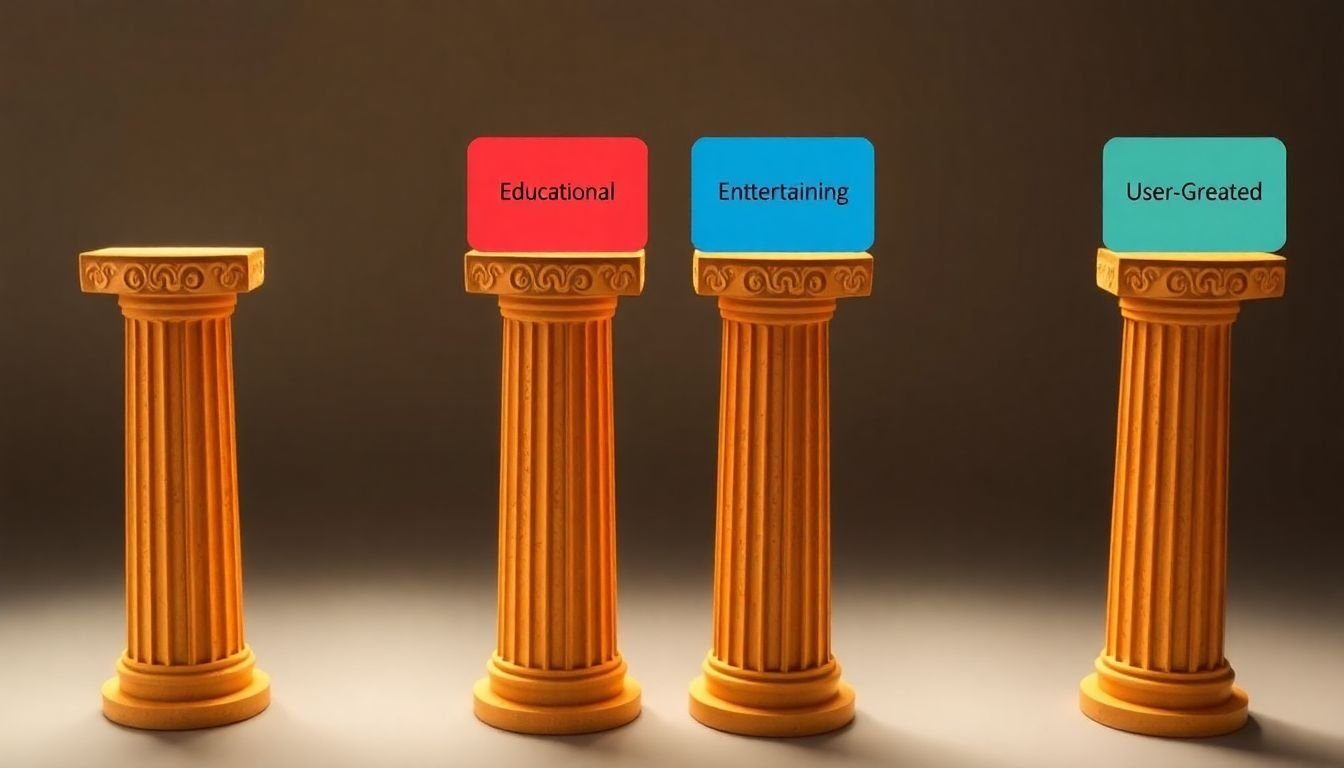
Content Pillars: The Building Blocks of Your Social Media Strategy
In the dynamic world of social media, crafting a compelling strategy is akin to constructing a robust building. Just as a building requires sturdy pillars to support its structure, your social media presence needs content pillars to uphold its engagement and growth. Content pillars, in essence, are the core themes or topics that your brand consistently creates content around. They are the building blocks of your social media strategy, providing a framework that guides your content creation and ensures it resonates with your audience.
Identifying your content pillars is a crucial step in this process. It involves understanding your brand’s mission, values, and target audience. For instance, if you’re a sustainable fashion brand, your content pillars might revolve around ‘Sustainable Materials’, ‘Ethical Production’, ‘Upcycling Trends’, and ‘Sustainable Living’. Each pillar should be unique yet interconnected, reflecting different aspects of your brand’s identity.
Once identified, content pillars help create a diverse and engaging content mix. Let’s explore this with some examples:
- Educational Pillars: These pillars aim to inform and educate your audience. For a tech company, this could be ‘Tech Tips & Tricks’ or ‘Industry Trends’.
- Entertaining Pillars: These pillars focus on engaging your audience with fun, light-hearted content. A food brand might use ‘Cooking Challenges’ or ‘Food Jokes’.
- Inspirational Pillars: These pillars aim to motivate and inspire your audience. A fitness brand might use ‘Success Stories’ or ‘Motivational Quotes’.
- Behind-the-Scenes Pillars: These pillars give your audience a peek into your brand’s inner workings. A small business might use ‘Meet the Team’ or ‘Our Creative Process’.
By strategically using these content pillars, you can create a balanced content mix that keeps your audience engaged, informed, and connected with your brand. It’s like a well-orchestrated symphony, where each instrument (or content pillar) plays its part to create a harmonious melody (or engaging social media presence).
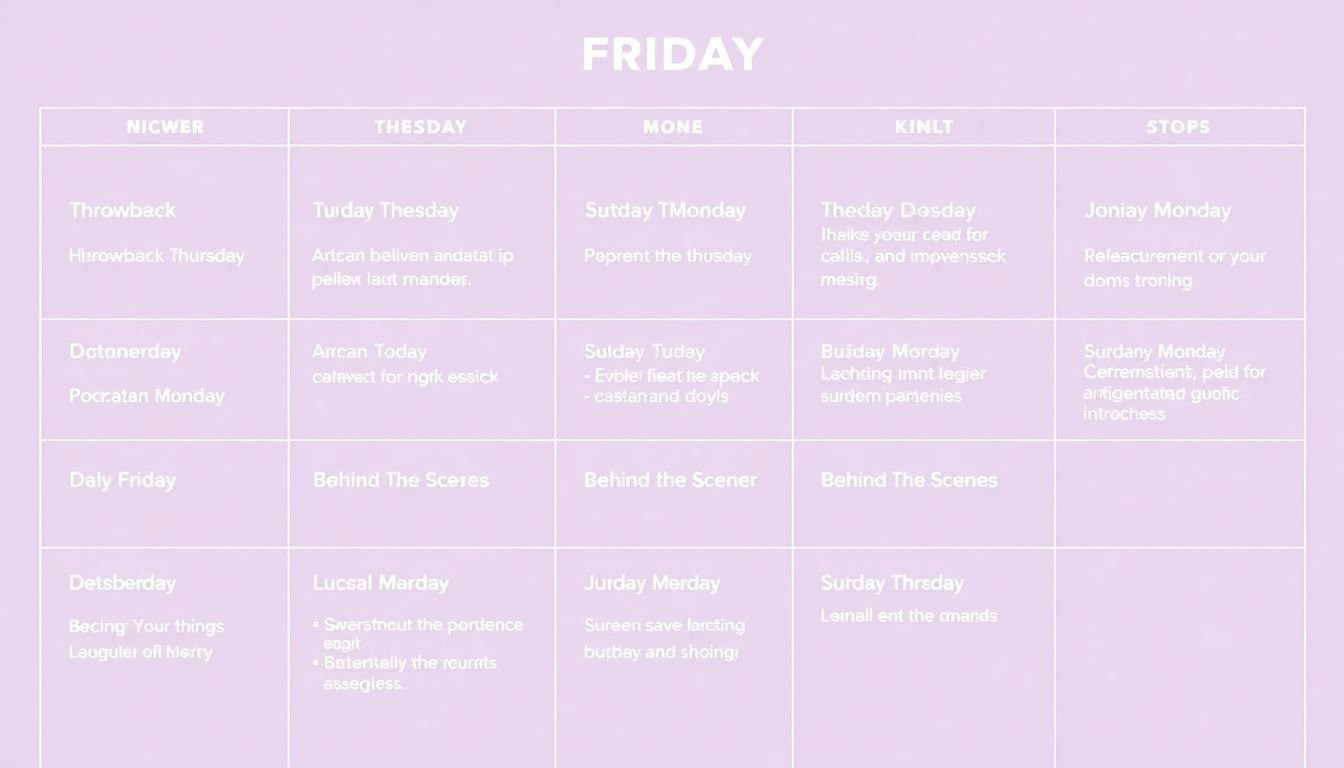
Weekly Content Themes: Your Roadmap to a Year of Engaging Posts
Embarking on a year-long social media journey can be both exciting and daunting. One strategy to keep your content fresh, engaging, and cohesive is to adopt weekly content themes. This approach helps you plan ahead, ensures variety in your posts, and makes it easier to connect with your audience on a deeper level.
Weekly content themes are like a roadmap for your social media presence. They provide a structure that guides your content creation, helping you to tell a story over time. By committing to a theme each week, you’re not only making your life easier with a consistent plan, but you’re also giving your audience something to look forward to and engage with.
Let’s explore some examples of weekly content themes and how they can be applied across various industries:
- Throwback Thursday (#TBT): This theme is perfect for businesses with a rich history or those looking to showcase their evolution. Each week, share an old photo, story, or piece of trivia related to your brand. This not only engages your audience but also helps them connect with your brand’s heritage.
- Meet the Team Monday: This theme is great for businesses that want to humanize their brand. Each week, introduce a team member, sharing their role, interests, and why they love working for your company. This helps build a personal connection with your audience and fosters a sense of community.
- Tip Tuesday: This theme is ideal for industries that can provide valuable insights or advice to their audience. Each week, share a tip related to your industry, whether it’s a marketing hack, a productivity tip, or a how-to guide. This positions your brand as a thought leader and provides value to your audience.
- Wisdom Wednesday: This theme is perfect for industries that can share inspiring or thought-provoking content. Each week, share a quote, a story, or a piece of wisdom related to your industry. This can be from a historical figure, a current leader, or even one of your team members.
- Fun Fact Friday: This theme is great for industries that can share interesting or little-known facts. Each week, share a fun fact related to your industry, your products, or your company. This can be a lighthearted way to engage your audience and spark conversation.
Remember, the key to successful weekly content themes is consistency and relevance. Choose themes that align with your brand and your audience’s interests. Stick to them, and watch as your social media presence becomes more cohesive, engaging, and meaningful.
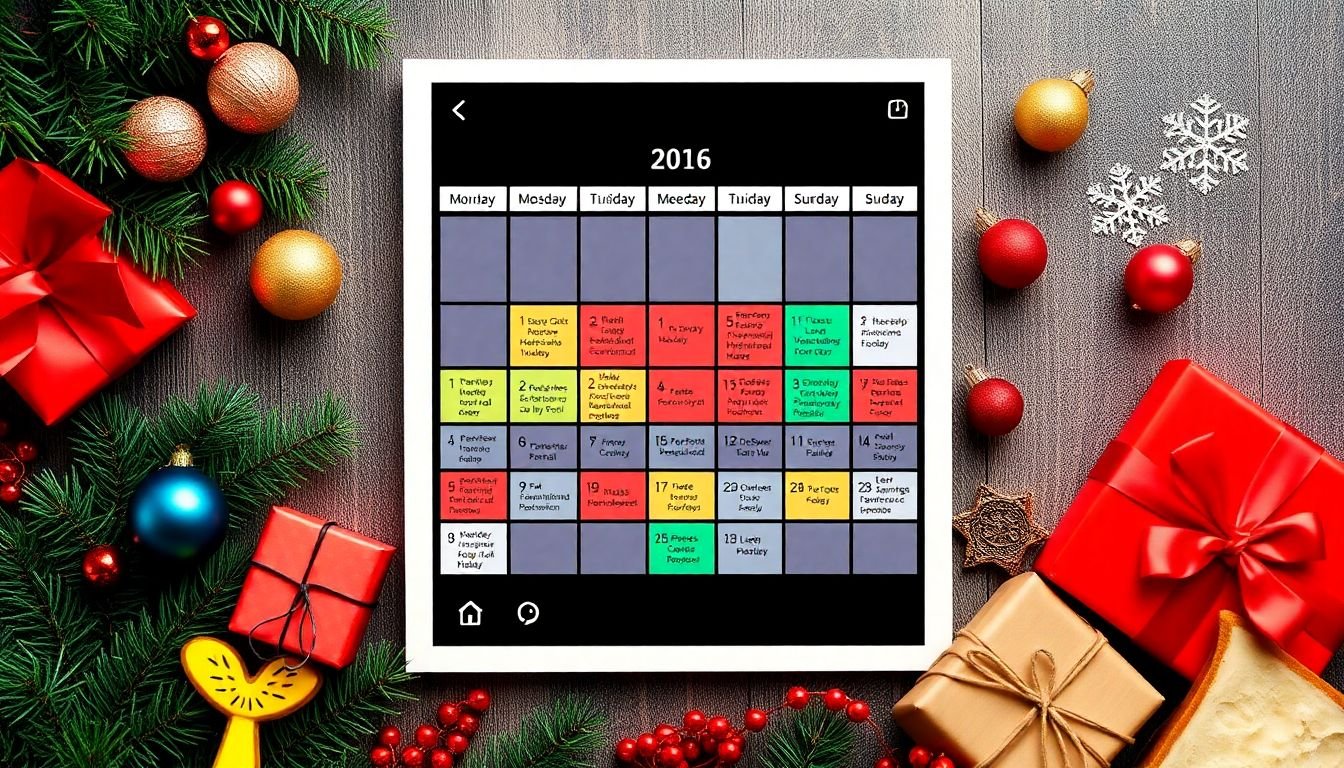
Holiday and Seasonal Content: Capitalize on Timely Opportunities
Embracing holiday and seasonal content is not just a fun way to engage your audience, but a strategic move that can significantly boost your content’s relevance and reach. The key lies in planning ahead and capitalizing on timely opportunities that resonate with your audience. Let’s dive into the world of holidays, events, and seasons, and explore how to create content that truly connects.
Throughout the year, we’re spoiled for choice when it comes to relevant topics. From the whimsy of Valentine’s Day to the spooktacular fun of Halloween, and the festive cheer of Christmas, each holiday offers a unique opportunity to create themed content. Don’t forget the power of seasons too
- think spring cleaning, summer vacations, fall foliage, and winter wonderlands. Even lesser-known events like National Pizza Day or International Women’s Day can provide inspiration.
To create timely and engaging content, start by understanding your audience. What holidays or events do they celebrate? What seasons do they look forward to? Once you’ve identified these, here are some steps to create content that resonates:
- Brainstorm Ideas: Think about how the holiday or season relates to your niche. For instance, a fitness blog could create a ‘New Year, New You’ series, while a food blog could share festive recipes.
- Plan Ahead: Create a content calendar to ensure you’re covering all relevant holidays and events. This also gives you time to create quality content.
- Be Authentic: Don’t force a connection if there isn’t one. Your audience will appreciate authenticity over a forced theme.
- Engage Your Audience: Encourage your audience to participate. This could be through comments, shares, or user-generated content.
Remember, the goal is to create content that’s not just timely, but also valuable and enjoyable. So, go ahead, let your creative juices flow, and make the most of these timely opportunities!
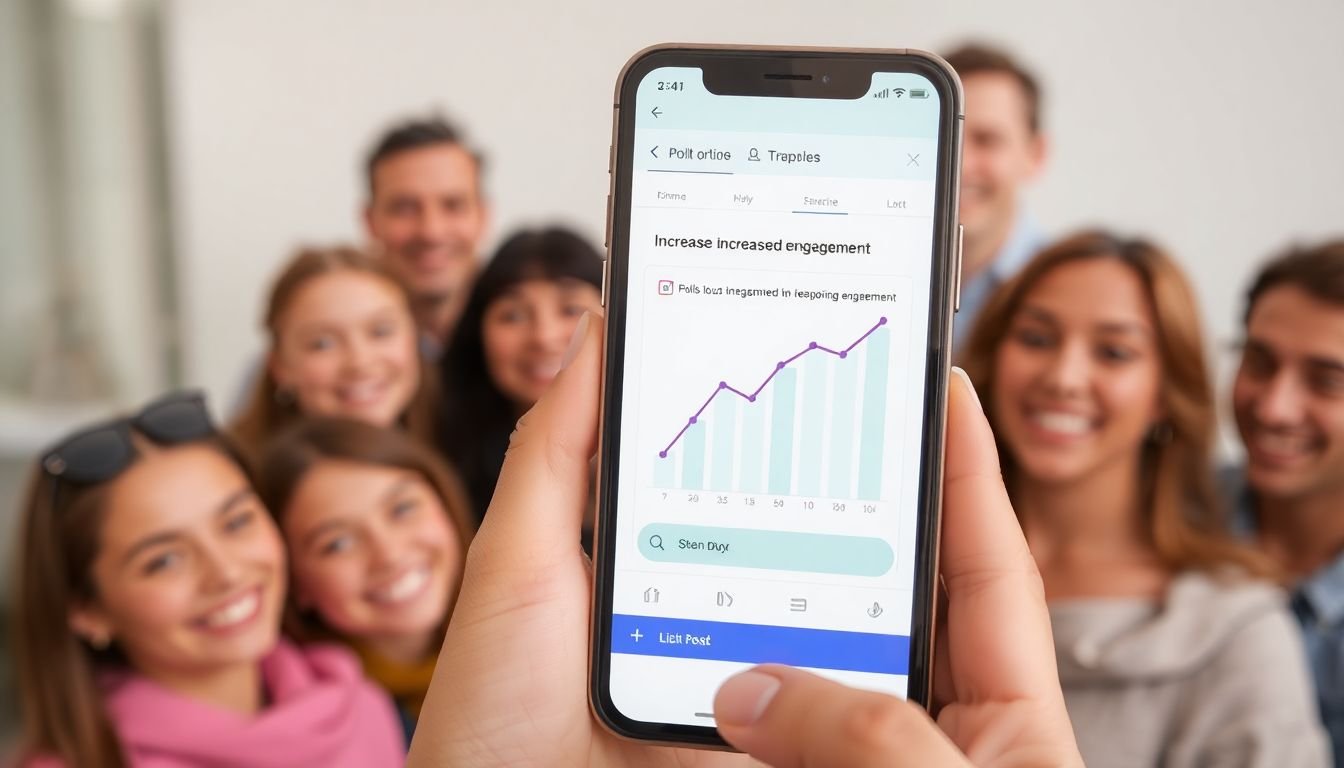
Engagement Strategies: Turning Passive Followers into Active Participants
In the dynamic world of social media, transforming passive followers into active participants is not just a goal, but a necessity. This shift from passive consumption to active engagement is the key to fostering a vibrant community around your brand or platform. One of the most effective ways to achieve this is by implementing a variety of engagement strategies that encourage interaction, foster a sense of belonging, and stimulate user-generated content.
The first strategy to consider is the classic ‘Ask Me Anything’ (AMA). AMAs provide a unique opportunity for your audience to connect with you on a personal level. By opening up the floor for questions, you’re not only providing valuable insights but also creating a dialogue that can lead to a deeper understanding of your audience’s needs and interests. This can be done through dedicated Q&A sessions or by regularly inviting your followers to ask you anything.
Polls and quizzes are another powerful tool for boosting engagement. These interactive elements not only make your content more fun and engaging but also provide you with valuable data about your audience. By asking your followers to vote or participate in a quiz, you’re encouraging them to actively think about and engage with your content. Moreover, these activities can foster a sense of community by sparking conversations and debates among your followers.
Giveaways and contests are yet another effective way to increase engagement. By offering incentives for participation, you’re encouraging your followers to actively interact with your content. This could be anything from asking them to share your post, tag friends, or create user-generated content. The key here is to make the rules of participation clear and the rewards enticing enough to motivate your followers to engage.
In conclusion, turning passive followers into active participants is a journey that requires a strategic and consistent approach. By incorporating ask-me-anythings, polls, quizzes, and giveaways into your content strategy, you’re not only increasing engagement but also fostering a sense of community and encouraging user-generated content. So, go ahead, give these strategies a try, and watch as your passive followers transform into active, engaged participants.

Storytelling and Authenticity: The Heart of Your Social Media Content
In the vast, ever-evolving landscape of social media, two elements stand out as the cornerstones of captivating content: storytelling and authenticity. These aren’t just buzzwords; they’re the heart and soul of any successful social media strategy. Let’s delve into the power of storytelling first.
Storytelling, as old as humanity itself, is the most potent tool in your content creator’s toolbox. It’s not just about sharing information; it’s about evoking emotions, sparking connections, and fostering engagement. To craft compelling narratives, start with a clear, concise hook. This could be a question, a surprising fact, or a vivid image that immediately draws your audience in. Then, build your story around a relatable character or situation, using vivid details and a compelling arc to keep your audience engaged. Remember, every story should have a resolution, even if it’s just a promise of more to come.
Now, let’s talk about authenticity. In a world filled with polished, often filtered content, genuine, real-life stories stand out. Authenticity builds trust and credibility, turning casual followers into loyal advocates. It’s about being true to your brand’s values, personality, and mission. Share behind-the-scenes glimpses, showcase your team’s unique voices, and don’t shy away from sharing your brand’s journey, warts and all. Authenticity isn’t about perfection; it’s about being relatable, human, and genuine.
To weave storytelling and authenticity into your social media content, consider these steps:
- Identify your brand’s unique voice and values.
- Find the stories that align with your brand’s mission and resonate with your audience.
- Craft compelling narratives around these stories, using vivid details and a clear arc.
- Infuse your stories with your brand’s authentic voice and values.
- Test, refine, and repeat, always staying true to your brand’s authentic narrative.

Repurposing and Repackaging Content: Maximizing Your Efforts
In the digital age, creating engaging content is a significant investment of time and resources. However, with a strategic approach, you can maximize your efforts by repurposing and repackaging your content into various formats. This not only extends the lifespan of your content but also caters to diverse learning styles and platforms.
The process begins with identifying your core content. This could be a blog post, a video, a podcast, or even a social media post. Once you have your core content, consider the following steps to repurpose and repackage it:
- Break it Down: Divide your content into smaller, digestible pieces. For instance, a long blog post can be broken down into a series of tweets or Instagram posts.
- Visualize it: Transform text-heavy content into visual formats. A blog post can be turned into an infographic, a SlideShare presentation, or even a series of quote images for Pinterest.
- Audio-ize it: Convert text or video content into podcast episodes or audio clips. This can cater to those who prefer listening to content while commuting or multitasking.
- Gamify it: Turn content into quizzes, polls, or games. This can increase engagement and make learning fun.
- Update and Refresh: Repurpose old content by updating it with new information or trends. This can help revive old posts and attract new audiences.
For example, a video explaining ‘How to Make the Perfect Pizza’ can be repackaged as:
- A step-by-step GIF series for quick reference
- A blog post with detailed instructions and photos
- A short, shareable video clip for social media
- An infographic with key tips and tricks
- A podcast episode with additional insights from a pizza chef
- A quiz to test viewers’ knowledge
By repurposing and repackaging your content, you’re not only maximizing your efforts but also providing your audience with a variety of ways to consume and engage with your content.

Analyzing and Adjusting: The Importance of Regular Content Audits
In the dynamic world of social media, content is not just king, but a restless monarch that demands constant attention and adjustment. Regularly analyzing and auditing your social media content is not a luxury, but a necessity that ensures your content strategy remains relevant, engaging, and effective. Think of it as giving your social media presence a periodic health check, ensuring it’s in tip-top shape to face the ever-changing digital landscape.
To begin, tracking performance metrics is the first step in this analytical journey. This involves measuring key performance indicators (KPIs) such as reach, engagement, clicks, shares, and conversions. These metrics provide a quantitative understanding of your content’s performance, helping you identify what’s working and what’s not. For instance, you might discover that your videos have a higher engagement rate than your images, or that your posts on a particular topic generate more shares.
Next, identifying trends is like reading the tea leaves of your content’s fortune. This involves analyzing patterns in your metrics over time. Are there certain days of the week when your posts perform better? Is there a particular time of day when your audience is most active? Are there seasonal trends affecting your content’s performance? Understanding these trends can help you optimize your posting schedule and capitalize on peak audience engagement.
Once you’ve analyzed your performance metrics and identified trends, it’s time to adjust your content strategy accordingly. This could involve:
- Producing more of the content types that perform well,
- Experimenting with new content formats to keep your audience engaged,
- Refining your content calendar to align with peak audience activity,
- Adapting your content themes to reflect emerging trends and topics.
Remember, the goal is not just to increase your metrics, but to build a deeper connection with your audience. Regular content audits help you understand what resonates with your audience, allowing you to create content that is not just seen, but also valued and shared.
So, don’t shy away from the numbers. Embrace them. Let them guide you. After all, data is not just about what happened, but about what can happen if you use it wisely. And that’s the power of regularly analyzing and adjusting your social media content.
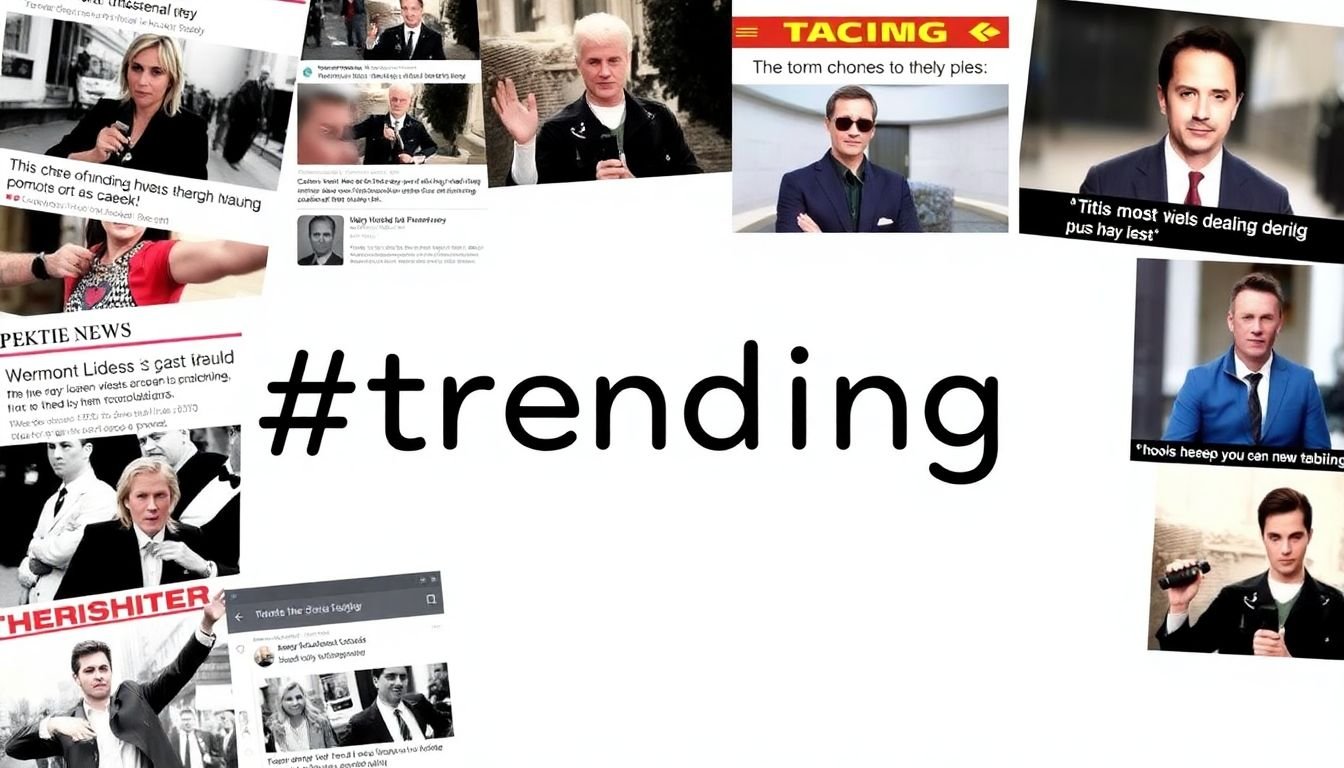
Keeping Up with Trends: Incorporating Current Events and Popular Culture
Staying current with trends in both current events and popular culture is not only fascinating but also beneficial, especially for those active on social media. To keep up, start by following reliable news sources and influencers in your niche. Websites like Google News, Twitter’s trending topics, and platforms like Reddit (r/news, r/popular, etc.) are excellent starting points.
For a more structured approach, set aside time each day to read articles, watch news updates, or listen to podcasts. This could be during your commute, lunch break, or before bed. Additionally, consider using news aggregator apps like Flipboard or Apple News to customize your news feed.
Incorporating trends into your social media content can boost engagement and relevance. Here are some steps:
- React Quickly: Trends come and go swiftly. Be ready to create and post content related to a trend while it’s still hot.
- Be Relevant: Ensure the trend aligns with your brand’s values and audience interests. Forced trends can backfire.
- Engage: Encourage your audience to interact with your trend-related content through polls, questions, or challenges.
Brands that have successfully capitalized on trends include Wendy’s with their witty Twitter responses to trending topics, and Netflix’s clever use of memes and pop culture references to promote their shows. For instance, they created a ‘Stranger Things’ themed game for the World Cup, capitalizing on both the show’s popularity and the global football fever. By staying trendy and relevant, these brands have fostered strong connections with their audiences.
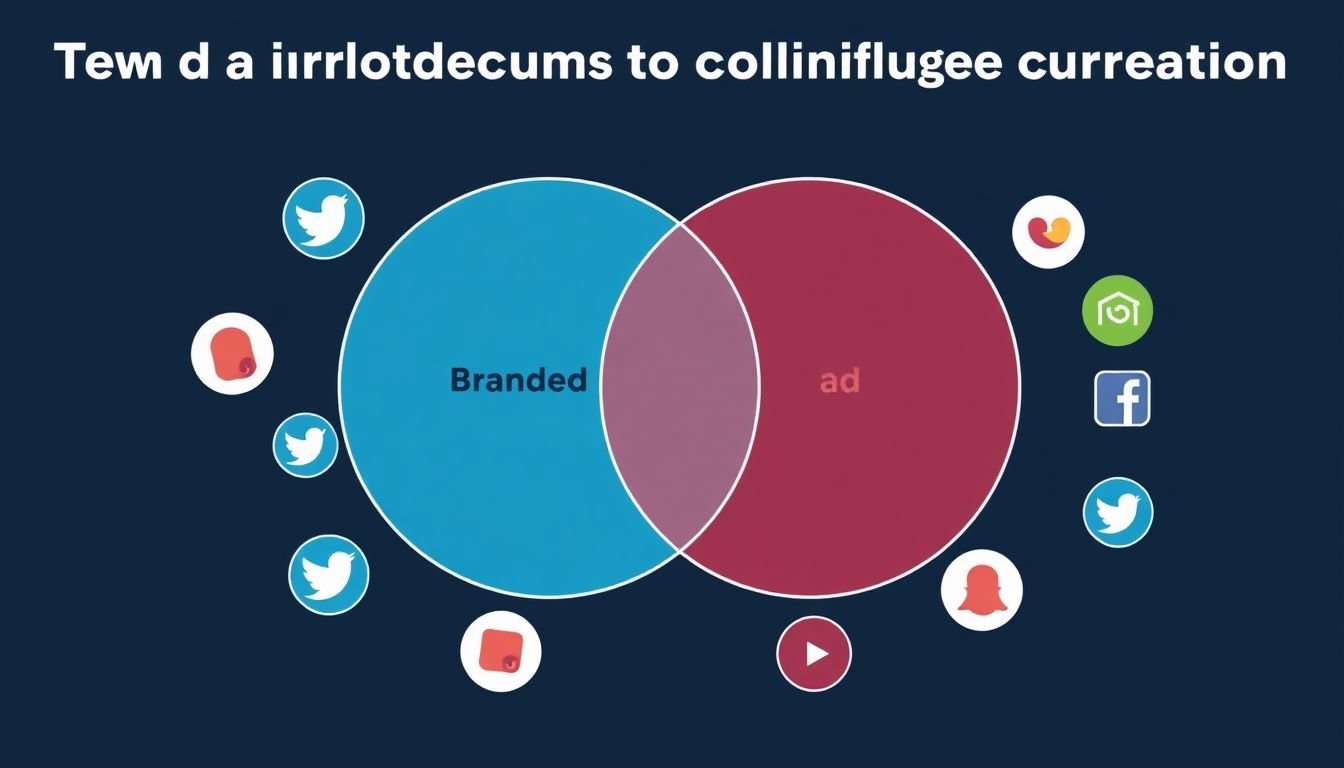
Collaborations and Partnerships: Expanding Your Reach Through Influencers and Brands
In the dynamic world of social media, expanding your reach isn’t just about creating great content; it’s also about who you know and who knows you. Collaborations and partnerships can be powerful tools to amplify your voice, engage new audiences, and foster growth. By teaming up with influencers and complementary brands, you’re essentially tapping into their established networks, exponentially increasing your visibility.
First, let’s talk about the benefits. Collaborations can introduce your content to a whole new pool of potential followers who share similar interests with your existing audience. They also humanize your brand, making it more relatable and authentic. Plus, they can drive traffic to your platforms and even boost your SEO.
Now, let’s dive into how to identify and approach potential collaborators. Start by looking for influencers or brands that align with your niche and values. They should have an engaged audience that would find your content valuable. Tools like BuzzSumo, Upfluence, or Grin can help you find these gems.
Once you’ve identified your dream collaborators, it’s time to reach out. Be genuine, respectful, and clear about your intentions. Explain why you think a collaboration would benefit both parties. Here’s a simple template:
- Hi [Name],
- I’m [Your Name] from [Your Platform]. I’ve been following your work and I think our audiences would really connect with each other.
- I had an idea for a collaboration…
- Looking forward to hearing your thoughts!
- Best,
- [Your Name]
When it comes to creating engaging content together, the sky’s the limit. It could be a joint blog post, an Instagram take-over, a YouTube collab, or even a live Q&A. The key is to make it valuable, entertaining, and true to both of your brands. Communicate openly about expectations, timelines, and promotion strategies. After all, you’re in this together!

Accessibility and Inclusivity: Creating Content for All
In the digital age, social media has become a powerful tool for connection, information, and self-expression. However, it’s crucial to remember that not everyone experiences this digital world in the same way. This is where accessibility and inclusivity come into play. Creating content that caters to diverse needs ensures that everyone can participate, engage, and enjoy the online space equally.
Imagine a visually impaired individual trying to understand a post without alt text, or a hearing-impaired person attempting to follow along with a video lacking closed captions. These barriers can make social media feel exclusive and unwelcoming. By implementing simple yet impactful strategies, we can break down these barriers and create a more inclusive digital environment.
Firstly, let’s talk about alt text. Alt text, or alternative text, is a brief description of an image that’s displayed when the image cannot be seen. It’s a lifeline for visually impaired users who rely on screen readers to navigate content. To add alt text, simply describe the image in a concise and accurate manner. For example, instead of ‘Image1’, use ‘A vibrant sunset over the ocean’.
Next, closed captions are vital for users who are hard of hearing or prefer to watch videos without sound. Most platforms have built-in tools to add captions, and there are also third-party services available. Remember, captions should include not just dialogue, but also important sound effects and music cues.
Color contrast is another often overlooked aspect. Low contrast between text and background can make content difficult to read, especially for users with visual impairments or color blindness. To ensure your content is accessible, use tools that check color contrast and adjust your color scheme accordingly.
In conclusion, creating accessible and inclusive content is not just about ticking off a checklist, but about fostering a digital community where everyone feels seen, heard, and valued. So, let’s make social media a place for all, one accessible post at a time!
FAQ
What is a Social Media Content Calendar and why is it important for 2024?
How can I create an effective Social Media Content Calendar for 2024?
- Set clear objectives for your social media presence.
- Choose the right platforms for your audience and goals.
- Plan your content mix, including types (e.g., images, videos, text updates) and themes (e.g., educational, entertaining, promotional).
- Use tools like Hootsuite, Buffer, or Sprout Social to schedule posts in advance.
- Regularly review and adjust your calendar based on performance data.
What are some content ideas for my Social Media Content Calendar in 2024?
- Educational: Blog posts, infographics, webinars, and Q&A sessions.
- Entertaining: Memes, jokes, challenges, and user-generated content.
- Promotional: New product launches, sales, and customer testimonials.
- Behind-the-scenes: Company culture, employee spotlights, and office tours.
- Trending topics: Newsjacking, seasonal events, and holidays.
- Interactive: Polls, quizzes, and contests.
Mix and match these ideas to keep your content fresh and engaging.
How can I ensure my content is engaging and drives interaction in 2024?
- Ask questions and encourage discussions.
- Use storytelling to connect with your audience on an emotional level.
- Leverage visuals, such as images and videos, to capture attention.
- Use relevant hashtags to increase visibility and encourage user-generated content.
- Collaborate with influencers and industry experts to create valuable content.
- Encourage user-generated content through contests and giveaways.
- Respond to comments and messages promptly to build relationships.
How often should I post on my social media platforms in 2024?
- Facebook: 1-2 posts per day
- Instagram: 1-2 posts and 2-3 stories per day
- Twitter: 3-5 tweets per day
- LinkedIn: 1 post per day (focus on quality and engagement)
- Pinterest: 5-10 pins per day
However, it’s essential to test and adjust your posting frequency based on your audience’s behavior and engagement data.
How can I repurpose content to maximize my Social Media Content Calendar in 2024?
- Turn blog posts into infographics or short videos.
- Share user-generated content and customer testimonials.
- Create a series of posts from a single piece of content (e.g., a long-form blog post).
- Repost evergreen content that remains relevant and valuable.
- Use content from other platforms (e.g., Instagram Stories to Facebook Stories).
- Update old content with fresh information and repost.
Repurposing content saves time and helps you maintain a consistent content calendar.
How can I measure the success of my Social Media Content Calendar in 2024?
- Reach and impressions
- Engagement rate (likes, comments, shares)
- Click-through rate (CTR)
- Conversions (e.g., sales, sign-ups, form submissions)
- Audience growth (followers, subscribers)
- Hashtag performance
- Posting frequency and consistency
Use analytics tools provided by each platform, along with third-party tools like Google Analytics, to track and analyze your performance.